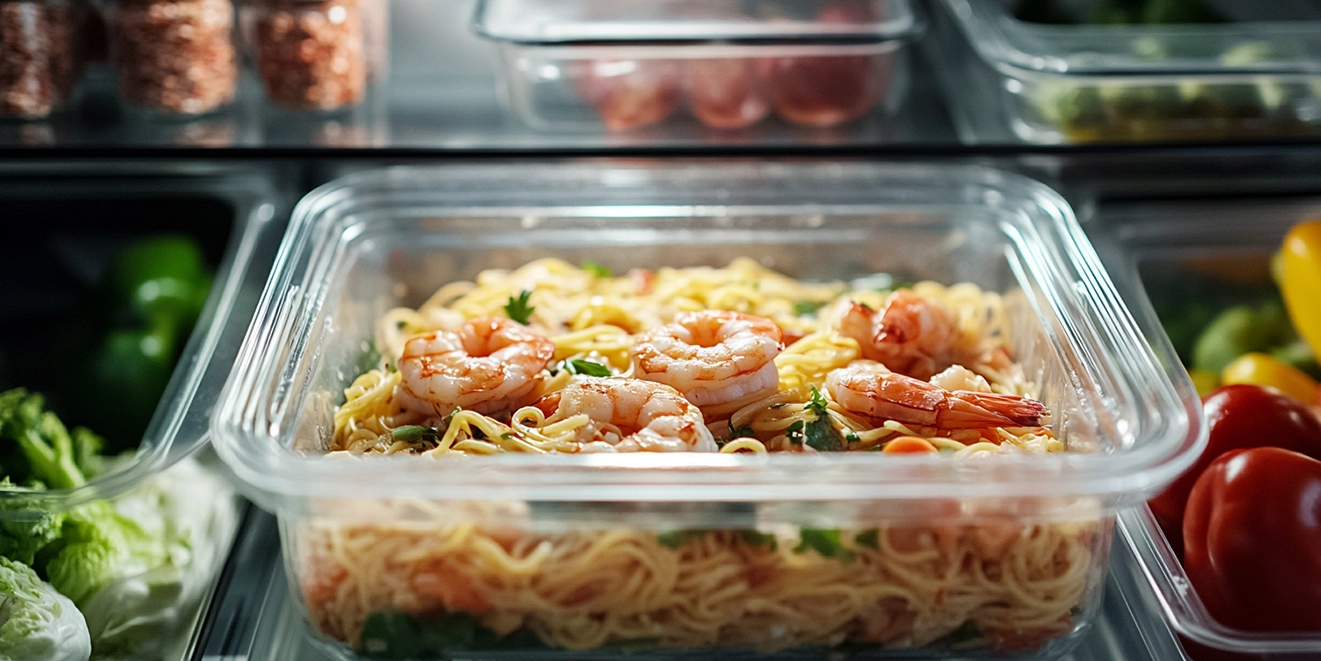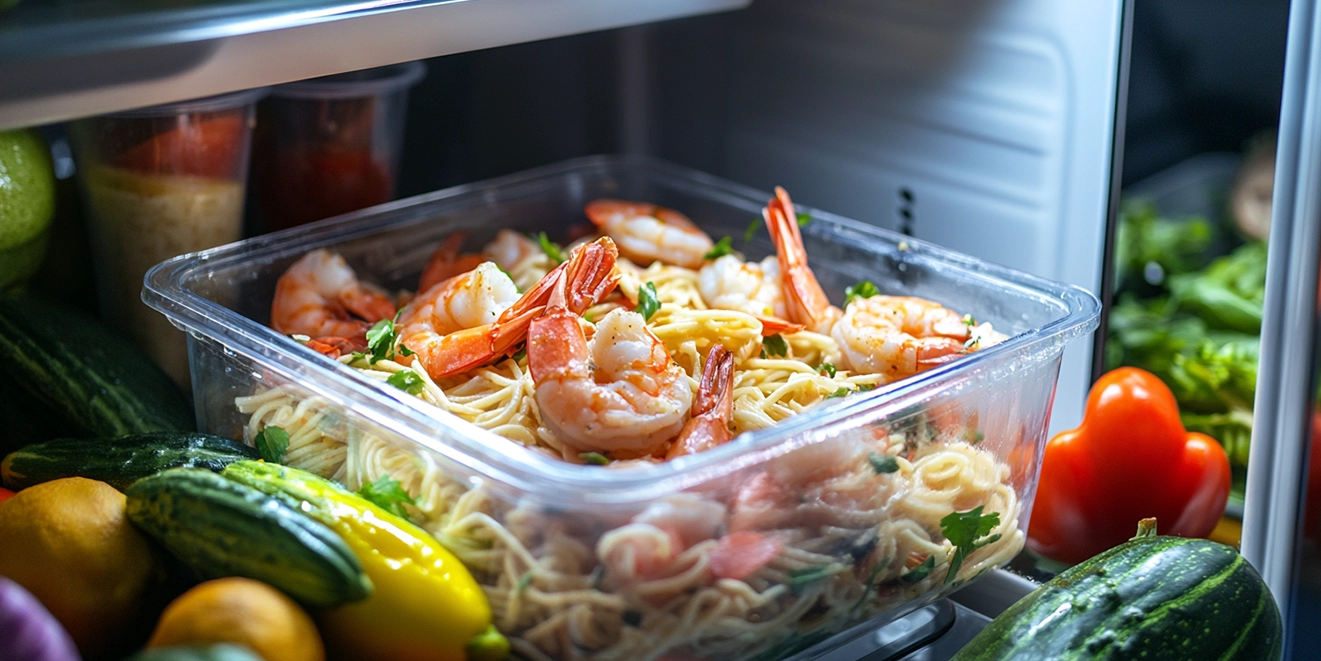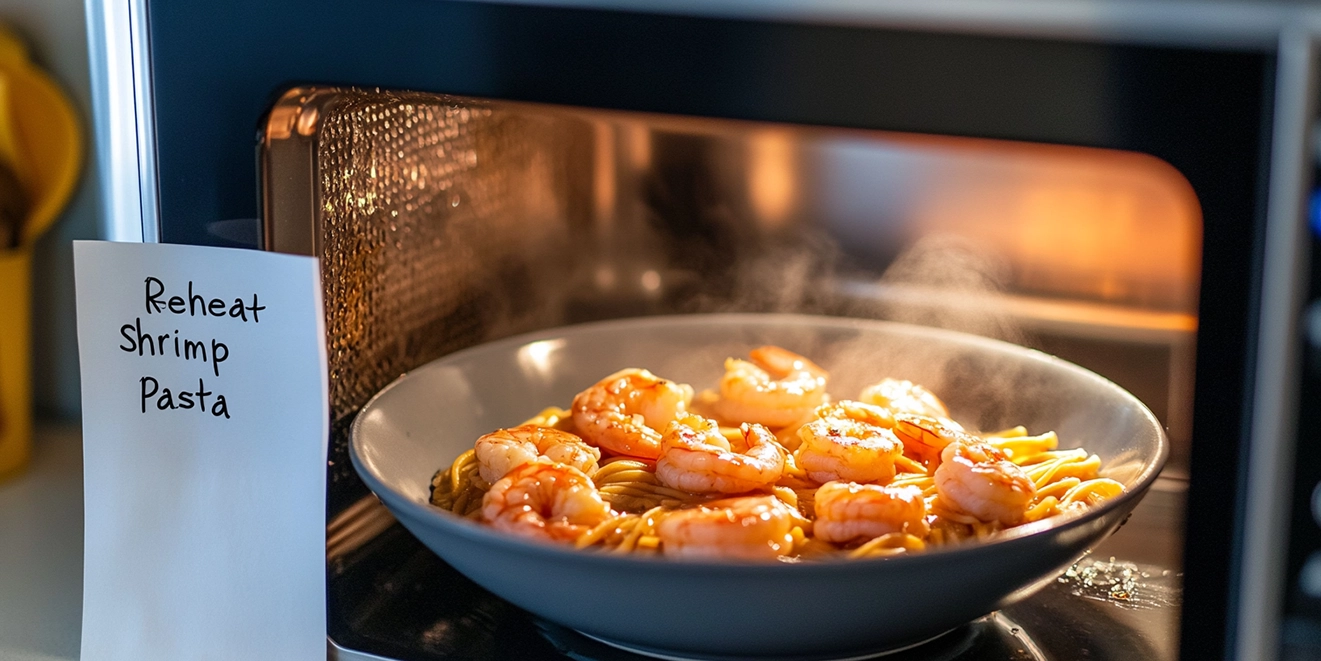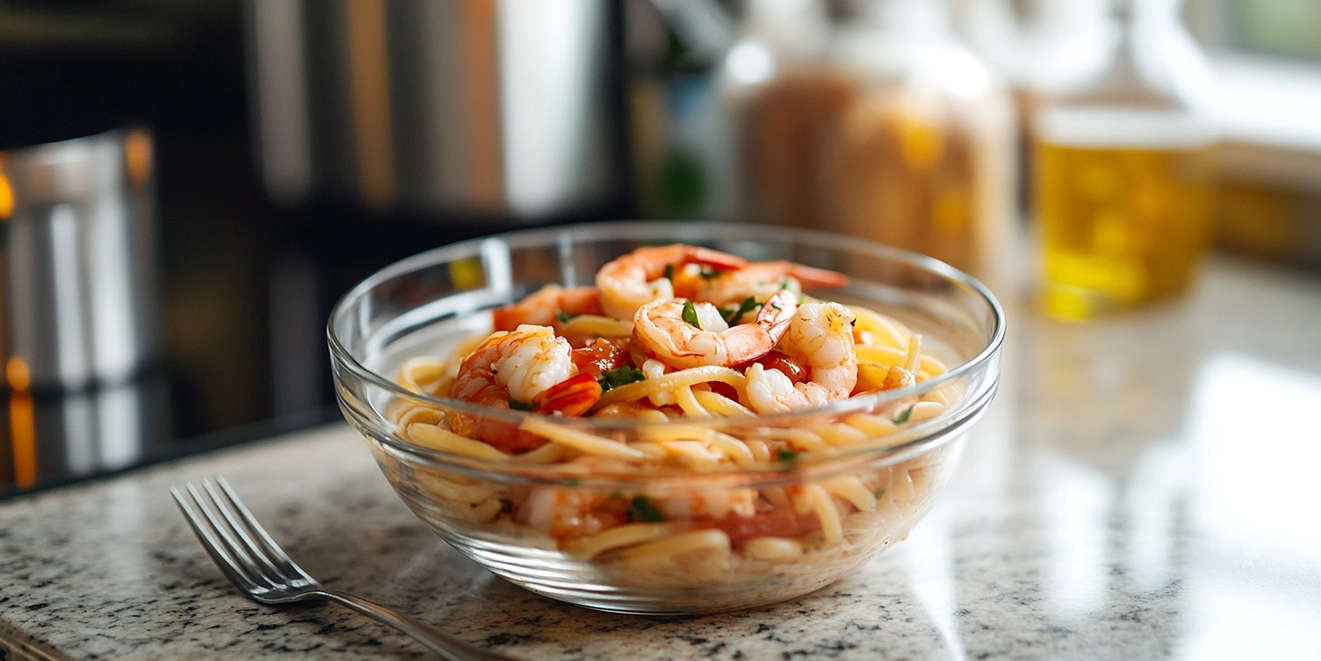How Long Does Shrimp Pasta Last? Storage, Shelf Life, and Reheating Tips

What Is Shrimp Pasta?
Shrimp pasta is a delightful and flavorful dish that combines tender shrimp with a variety of pasta types. It is often tossed in a rich sauce made from ingredients like garlic, olive oil, butter, cream, and fresh herbs. It’s a versatile and easy-to-make meal, perfect for a weeknight dinner or a special occasion.
Ingredients:
- Shrimp: Typically, medium to large-sized shrimp are used, either peeled and deveined or with shells for added flavor.
- Pasta: The choice of pasta can vary, but standard options include spaghetti, linguine, fettuccine, or penne.
- Garlic: Minced garlic adds a savory, aromatic base to the dish.
- Olive Oil or Butter: These fats are used to sauté the shrimp and create the sauce base.
- Cream or Tomato: Creamy shrimp pasta recipes often include heavy cream, while some versions use a tomato-based sauce.
- Herbs and Seasonings: Fresh parsley, basil, red pepper flakes, and lemon zest enhance the dish’s flavor profile.
- Cheese: Grated Parmesan or Romano is commonly used to finish the dish.
Cooking Process:
- Cook the pasta: Boil the pasta according to package instructions until al dente.
- Prepare the shrimp: Sauté the shrimp in olive oil or butter with garlic until pink and fully cooked.
- Make the sauce: Add cream or tomato sauce to the pan, adjusting seasoning with herbs and spices.
- Combine: Toss the cooked pasta in the sauce, adding shrimp for a delicious, flavorful mix. Finish with grated cheese and fresh herbs.
Popularity:
Shrimp pasta is a beloved dish in many cuisines, particularly Mediterranean and Italian cooking. Its combination of seafood and pasta makes it an appealing choice for seafood lovers. The dish’s versatility means it can be adapted with various sauces, spices, and accompaniments, making it a favorite in homes and restaurants worldwide. Whether served as a decadent, creamy indulgence or a light, zesty meal, shrimp pasta remains a timeless, crowd-pleasing favorite.
The Shelf Life of Shrimp Pasta
How Long is Shrimp Pasta Good For in the Fridge?
Shrimp pasta, like most seafood dishes, has a relatively short shelf life when stored in the refrigerator. To ensure its safety and maintain the best quality, here’s what you need to know:
In the Refrigerator:
- Shelf Life: Shrimp pasta stays fresh in the fridge for 1 to 2 days when stored properly.
- Storage: To maximize freshness, place the shrimp pasta in an airtight container or tightly wrap it in plastic wrap or foil to prevent air exposure, which can lead to spoilage.
Signs of Spoilage:
- Smell: A sour or off-putting odor indicates that the pasta has gone bad.
- Texture: If the shrimp becomes slimy or mushy, it is no longer safe to eat.
- Color: Any noticeable color changes, especially with the shrimp (such as turning grayish or discolored), should be treated as a sign of spoilage.
Freezing Shrimp Pasta:
If you need to keep shrimp pasta for a more extended period, freezing is an option:
- Freezer Storage: Shrimp pasta can be stored in the freezer for 1-2 months. To avoid freezer burn, pack it in an airtight container or freezer-safe bag.
- Reheating: When reheating frozen shrimp pasta, it’s best to thaw it overnight in the fridge and then warm it on the stovetop or in the microwave with a splash of cream or broth to revive the sauce’s texture.
Factors That Affect Shrimp Pasta’s Shelf Life

The shelf life of shrimp pasta is influenced by several factors, including temperature, storage method, and the ingredients used in the dish. Understanding these factors can help you maximize freshness and minimize food waste.
Temperature
- Refrigeration: Shrimp pasta should be stored in the fridge below 40°F (4°C). Proper refrigeration slows down bacterial growth, which helps maintain the dish’s safety and quality. If the pasta is left at room temperature for more than 2 hours, it should be discarded, as bacteria can proliferate in warmer conditions.
- Freezing: Freezing shrimp pasta can significantly extend its shelf life. At temperatures of 0°F (-18°C) or lower, shrimp pasta can last for 1-2 months. However, freezing can affect the texture of the pasta and shrimp, so it’s best to consume it within this time frame for the best taste.
Storage Method
- Airtight Containers: Store shrimp pasta in an airtight container to prevent spoilage. This helps keep out air, moisture, and contaminants, which can accelerate spoilage. If you’re storing it in plastic wrap or foil, ensure it’s tightly sealed.
- Refrigerator or Freezer: Whether refrigerating or freezing, always ensure the shrimp pasta is cooled down to room temperature before storage. Putting hot food directly in the fridge or freezer can raise the temperature and potentially cause harmful bacteria to grow.
Ingredients
- Shrimp: Shrimp is a highly perishable seafood ingredient that can spoil quickly if not stored correctly. When initially cooked, the freshness of the shrimp is a key factor in determining how long the pasta will last. Using fresh, high-quality shrimp will ensure the pasta stays fresh longer.
- Cream-Based Sauces: If the shrimp pasta includes a cream or dairy-based sauce, it will spoil faster than pasta with a tomato or oil-based sauce. Dairy products have a shorter shelf life and can sour or curdle over time, especially if not stored at the proper temperature.
- Acidic Ingredients: Ingredients like lemon juice, tomatoes, or vinegar may slightly extend the freshness of shrimp pasta by slowing down bacterial growth. However, they are not a guarantee that the dish will last longer.
- Herbs and Fresh Garnishes: Fresh herbs and garnishes, like parsley or basil, can wilt and quickly lose flavor. It’s best to add these fresh when serving rather than storing them with the pasta.
How to Tell if Shrimp Pasta Has Gone Bad
When storing shrimp pasta, checking for signs of spoilage is essential to avoid consuming food that could make you sick. Here are the key indicators that shrimp pasta has gone bad:
Off Smell
One of the most noticeable signs that shrimps pasta has spoiled is a sour, rancid, or unpleasant odor. Fresh shrimp should have a mild, brine scent, but the smell will become much stronger and more distasteful as it spoils. If the pasta has developed an off smell, it is best to discard it.
Texture Changes
Changes in texture are another red flag. Fresh shrimp should have a firm, slightly bouncy texture. It will likely spoil if the shrimp becomes slimy, mushy, or rubbery. Additionally, if the pasta becomes soggy or sticky (instead of retaining its normal texture), it’s a sign that it’s no longer safe to eat.
Mold Growth
Mold growth is a clear indication that shrimp pasta has gone bad. Discard the dish immediately if you notice any fuzzy, green, or black spots on the pasta, shrimps, or sauce. Mold can develop if the pasta is not stored correctly, especially if it is exposed to air or kept at an unsafe temperature for too long.
Color Changes
While minor color variations may occur naturally over time, dramatic changes in color, particularly with the shrimp (turning gray or black), are a warning sign. The pasta sauce may also appear discolored or separate if it’s gone bad, especially if it’s cream-based.
Taste
If uncertain, you can taste a small amount but still consider eating leftover shrimp pasta. If it has an off, sour, or unpleasant flavor, it’s time to discard it. Always trust your senses—if anything about the smell, texture, or taste seems off, it’s better to be safe and throw the dish away.
By paying attention to these signs, you can avoid eating spoiled shrimp pasta and ensure your meals remain safe and enjoyable.
How to Reheat Shrimp Pasta Safely

Reheating shrimps pasta correctly is essential to maintain its taste, texture, and safety. Improper reheating can lead to overcooked shrimp, dried-out pasta, or unevenly heated food. Here are the best methods for reheating shrimp pasta without compromising flavor or quality.
Reheating on the Stovetop
The stovetop is one of the best methods for reheating shrimps pasta, as it allows you to control the temperature and moisture levels:
- Steps:
- Place the shrimps pasta in a pan over medium-low heat.
- Add a small amount of liquid (such as cream, broth, or a splash of water) to help loosen the sauce and prevent the pasta from drying out.
- Stir occasionally to ensure the shrimp is not overcooked, even when heating.
- Heat until the pasta is warmed through and the shrimp reaches an internal temperature of 145°F (63°C).
Reheating in the Microwave
Microwaving is quick and convenient, but it’s easy to overheat the shrimp or dry out the pasta. Here’s how to do it properly:
- Steps:
- Place the shrimps pasta in a microwave-safe dish.
- Add a small amount of liquid (like broth or cream) to maintain moisture.
- Cover the dish with a microwave-safe lid or a damp paper towel to prevent it from drying out.
- Microwave in short bursts of 30 seconds to 1 minute, stirring in between to ensure even heating.
- Check that the pasta is evenly heated and the shrimp reaches an internal temperature of 145°F (63°C).
Reheating in the Oven
Reheating in the oven can help retain the texture of the shrimp pasta, especially if it’s a baked version, but it’s slower than the stovetop or microwave.
- Steps:
- Preheat your oven to 350°F (175°C).
- Place the shrimps pasta in an oven-safe dish and cover it with aluminum foil to retain moisture.
- Bake for 15-20 minutes, or until the pasta is heated through. If the pasta is very dry, add a little liquid before covering it with foil.
- Ensure the shrimp reaches an internal temperature of 145°F (63°C) before serving.
Avoid Reheating More Than Once
To ensure safety and quality, it’s best not to reheat shrimps pasta more than once. Repeated heating and cooling increase the risk of bacterial growth and degrade the taste and texture. Only reheat what you plan to eat.
Extending the Freshness of Shrimp Pasta

If you want to make your shrimps pasta last longer and maintain its freshness, there are several tips and tricks for storage and preparation. These methods help preserve the dish’s taste, texture, and safety.
Proper Storage
- Cool Down Quickly: After cooking, allow the shrimps pasta to cool to room temperature before storing it. Avoid leaving it out for more than 2 hours, as bacteria can proliferate at room temperature.
- Airtight Containers: Store shrimps pasta in airtight containers to prevent air from getting in, which can dry out the pasta or lead to contamination. You can also use plastic wrap or foil, but ensure it’s tightly sealed.
- Separate the Sauce: If possible, store the shrimp and sauce separately from the pasta. This helps keep the pasta from becoming too soggy and prevents overcooking the shrimp when reheating.
- Refrigerate Immediately: Place the shrimp pasta in the refrigerator within 2 hours of cooking. Store it at or below 40°F (4°C) to slow bacterial growth and extend freshness.
Freezing Shrimps Pasta
Freezing is an excellent option for storing shrimp pasta for extended periods. The dish can stay fresh for 1-2 months in the freezer.
- Freezer-Safe Containers: Use freezer-safe bags or airtight containers to prevent freezer burn and protect the shrimp pasta’s flavor. If you freeze pasta with cream sauce, consider using a thicker sauce to avoid separation when reheating.
- Label and Date: Label the container with the freezing date so you can track how long it’s been stored.
- Portion Control: If you have a large batch of shrimp pasta, consider freezing it in smaller portions. This allows you to reheat only what you need and prevents repeated thawing and refreezing.
Use Fresh Ingredients
- Fresh Shrimp: The quality of the shrimp plays a significant role in how long your dish will last. Use fresh, high-quality shrimp to ensure a longer shelf life. If you’re using frozen shrimp, thaw it properly in the refrigerator before cooking.
- Herbs and Garnishes: Fresh herbs, like parsley or basil, can wilt and lose their flavor quickly. Instead of mixing them into the pasta, sprinkle them on top before serving. This helps preserve their freshness.
Avoid Overcooking the Shrimp
Shrimp cook quickly, and overcooking can produce a tough, rubbery texture. Undercooking slightly can help prevent this, as the shrimp will finish cooking when reheated without becoming overdone.
Use a Thicker Sauce
If you’re making shrimps pasta with a creamy or butter-based sauce, consider using a thicker sauce. Thinner sauces, especially made with cream, can break down or separate during storage and reheating. Thicker sauces will hold up better, ensuring the dish remains creamy and flavorful when reheating.
Reheat Gently
When reheating shrimps pasta, do so gently to prevent the shrimp from becoming brutal or overcooked. Use lower heat and add a bit of liquid (such as cream or broth) to retain moisture, especially when reheating on the stovetop or in the microwave.
By following these tips, you can extend the freshness of your shrimps pasta, reduce waste, and ensure that your dish stays as delicious as the day it was made.
Frequently Asked Questions (FAQs)
How long is leftover shrimp pasta good for?
Leftover shrimps pasta can typically last 1 to 2 days in the refrigerator if stored properly in an airtight container. It’s important to refrigerate it promptly after cooking and consume it within this time to ensure its safety and freshness.
Can I eat cooked shrimp after 5 days?
It’s not recommended to eat cooked shrimp after 5 days. Shrimp is highly perishable and can spoil quickly, even when refrigerated. To avoid foodborne illness, it is best to consume cooked shrimp within 3 to 4 days of preparation.
How long does prawn pasta last in the fridge?
When stored properly, shrimp pasta (like shrimp) will last for 1 to 2 days in the fridge. To slow down spoilage, keep it in an airtight container and keep the fridge temperature below 40°F (4°C).
How many days can you eat shrimp pasta?
You can safely eat shrimp pasta for up to 2 days after it’s been cooked and stored in the refrigerator. After that, the quality and safety of the dish may decline, and the risk of foodborne illness increases. Always check for signs of spoilage, such as an off smell, slimy texture, or mold growth.
Conclusion
Shrimps pasta is a delicious and versatile dish that can be enjoyed in many variations. However, like all seafood-based meals, it has a limited shelf life. You can extend its freshness and enjoy it safely by following proper storage and reheating methods. Remember to refrigerate leftovers promptly, consume them within 1-2 days, and be mindful of signs of spoilage such as off smells, texture changes, or mold growth. If you want to keep shrimp pasta for a more extended period, freezing it is a great option. With the proper care, you can make the most of your shrimp pasta leftovers while ensuring they remain safe and tasty.
